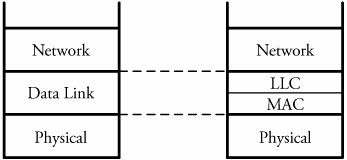Section 5.2. LAN Protocols
5.2. LAN ProtocolsProtocols designed for layers 3 and above are independent of the underlying network topology. Hence, protocols designed for LANs are normally concerned with the data-link layer and the physical layer. Organizations working on LAN standards comply with the specifications of IEEE 802 reference model. The physical layer of a LAN implements such functions as signal transmission and reception , encoding and decoding, and generation and removal of synchronization information. The physical layer also specifies the type of medium used for transmission and the network topology. Figure 5.2 shows the position of the two LAN sublayers in the overall structure of the protocol stack. The IEEE 802 standard subdivides the data-link layer of the protocol model into the logical-link control (LLC) layer and the media access control (MAC) layer. The LLC layer implements flow and error control apart from providing an interface to the network layer. The MAC layer primarily controls the access to transmission medium and is responsible for framing. LLC has the option of choosing from various types of MAC layers. Figure 5.2. LAN sublayer protocols in the overall structure of the protocol stack 5.2.1. Logical-Link Layer (LLC)Data to be transmitted from the higher layers is passed down to the logical-link layer , which determines the mechanism for addressing users across the medium. The LLC also controls the exchange of data between each two users. The LLC appends its header to form the LLC protocol data unit, which is then sent to the MAC layer, which appends the header and the frame check sequence to create the MAC frame. 5.2.2. Medium Access Control (MAC)A LAN is required to provide sharing access to the transmission medium. To ensure efficient access to a medium, users have to comply with some rules. The MAC protocol manages access to the medium. Figure 5.3 shows a generic MAC frame format within frame formatting for the MAC protocol. The fields of the frame format are as follows .
Figure 5.3. Generic MAC frame format The next section provides a detailed discussion on MAC and its interaction with IP addresses. |
EAN: 2147483647
Pages: 211
- Chapter III Two Models of Online Patronage: Why Do Consumers Shop on the Internet?
- Chapter IV How Consumers Think About Interactive Aspects of Web Advertising
- Chapter VI Web Site Quality and Usability in E-Commerce
- Chapter XVII Internet Markets and E-Loyalty
- Chapter XVIII Web Systems Design, Litigation, and Online Consumer Behavior
